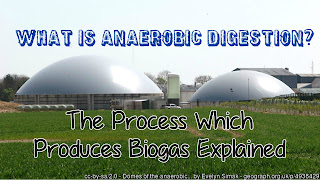Many people wonder what those partly spherical, and partly egg-shaped, tanks in multiples of two to four really are at their local sewage works.
That's why we wrote this article, and a video (see below) on exactly the same subject, namely: "Anaerobic Digesters - those Strange Looking Tanks Explained"
Have you ever wondered what those huge "otherworldy", and futuristic, spherical tanks are that you sometimes see while out driving?
They are anaerobic digestion process digesters, and very useful they are too!
When you hear why they are built in that shape, you will be intrigued at the way that the designers have thought of so many problematic aspects of their AD process. Then they used careful attention to the shape of these biogas reactors to make the process work much better than it would in standard square, rectangular or circular tanks.
These digesters are themselves very valuable because they make sewage sludge much more wholesome and in particular they reduce sludge odour.
But, best of all, they make large amounts of renewable energy to power the sewage works they form part of. Many of them export their spare "green" electricity to the local power grid.
Ratepayers benefit by the reduced cost of their sewage treatment, due to these companies ploughing back the revenue from selling the electric power, from these digesters, into the sewage works accounts, to offset the sewage treatment operating costs.
Egg-shaped digesters originated in Germany in the 1950s and it is thought that all are used to treat sewage works sludge.
If you found our article, and the above video interesting, now read more at our website.
Go to: www.anaerobic-digestion.com/anaerobic-digestion-basics/anaerobic-sludge-digestion/
This video was inspired by the presentation on egg-shaped digesters at http://mebig.marmara.edu.tr/Enve424/Chapter8.pdf
That's why we wrote this article, and a video (see below) on exactly the same subject, namely: "Anaerobic Digesters - those Strange Looking Tanks Explained"
Have you ever wondered what those huge "otherworldy", and futuristic, spherical tanks are that you sometimes see while out driving?
They are anaerobic digestion process digesters, and very useful they are too!
When you hear why they are built in that shape, you will be intrigued at the way that the designers have thought of so many problematic aspects of their AD process. Then they used careful attention to the shape of these biogas reactors to make the process work much better than it would in standard square, rectangular or circular tanks.
These digesters are themselves very valuable because they make sewage sludge much more wholesome and in particular they reduce sludge odour.
But, best of all, they make large amounts of renewable energy to power the sewage works they form part of. Many of them export their spare "green" electricity to the local power grid.
Ratepayers benefit by the reduced cost of their sewage treatment, due to these companies ploughing back the revenue from selling the electric power, from these digesters, into the sewage works accounts, to offset the sewage treatment operating costs.
Egg-shaped digesters originated in Germany in the 1950s and it is thought that all are used to treat sewage works sludge.
- The steeply sloped bottom of the tank eliminates grit accumulation.
- Grit can easily be removed from the bottom, therefore, cleaning is not required.
- Liquid surface area at the top is small, so scum can be kept fluid with a mixer, and removed through a scum door.
- Egg-shaped digesters can be built with steel or concrete.
- Steel construction is more common because concrete construction requires complex formwork and special construction techniques.
If you found our article, and the above video interesting, now read more at our website.
Go to: www.anaerobic-digestion.com/anaerobic-digestion-basics/anaerobic-sludge-digestion/
This video was inspired by the presentation on egg-shaped digesters at http://mebig.marmara.edu.tr/Enve424/Chapter8.pdf




